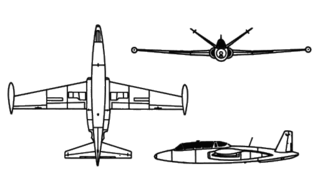Loading AI tools
Type of aircraft From Wikipedia, the free encyclopedia
The Fouga Zéphyr (company designation CM.175) was a 1950s French two-seat carrier-capable jet trainer for the French Navy. It was developed from the land-based CM.170 Magister. The Zéphyr was retired in 1994.
| CM.175 Zéphyr | |
|---|---|
 | |
| A Fouga CM.175 Zéphyr in French Navy colours | |
| Role | Carrier-capable jet trainer |
| National origin | France |
| Manufacturer | Fouga |
| First flight | 31 July 1956 (as CM.170M) |
| Introduction | 1959 |
| Retired | 1994 |
| Primary user | French Navy |
| Number built | 32 |
| Developed from | Fouga CM.170 Magister |

The French Navy's Aéronavale adopted a derivative of the Fouga CM.170-1 Magister as a basic trainer for carrier operations.[1] Originally designated CM-170M Esquif, the prototype first flew on 31 July 1956, and was redesignated as the CM.175 Zéphyr soon after. Carrier trials were conducted from HMS Eagle (R05) and HMS Bulwark (R08) off the French coast in August 1957 and March 1958.[1]
The Zéphyr differed from the Magister in being equipped with an arrester hook and a modified structure and undercarriage strengthened for carrier operations.[1] The Zéphyr also included a nose-mounted light. As it did not have ejection seats, the Zéphyr had new sliding canopy hoods which could be locked open during carrier launchings and landings. One six-round rocket pod could be mounted under each wing for weapons training. Two guns could be fitted in the nose, but these were seldom carried. Thirty-two aircraft were delivered.[1]
The first production aircraft first flew on 30 May 1959 and entered service in October 1959 with 59S the deck landing school at Hyéres. The squadron used only 14 aircraft at a time with the others being kept in short-term storage and periodically rotated to even out the flying hours. In 1962 the unit formed an aerobatic team using the Zéphyr called the Patrouille de Voltige d'Hyéres.

Data from Carrier Aviation Air Power Directory [1]
General characteristics
Performance
Armament
Related development
Aircraft of comparable role, configuration, and era
Seamless Wikipedia browsing. On steroids.
Every time you click a link to Wikipedia, Wiktionary or Wikiquote in your browser's search results, it will show the modern Wikiwand interface.
Wikiwand extension is a five stars, simple, with minimum permission required to keep your browsing private, safe and transparent.